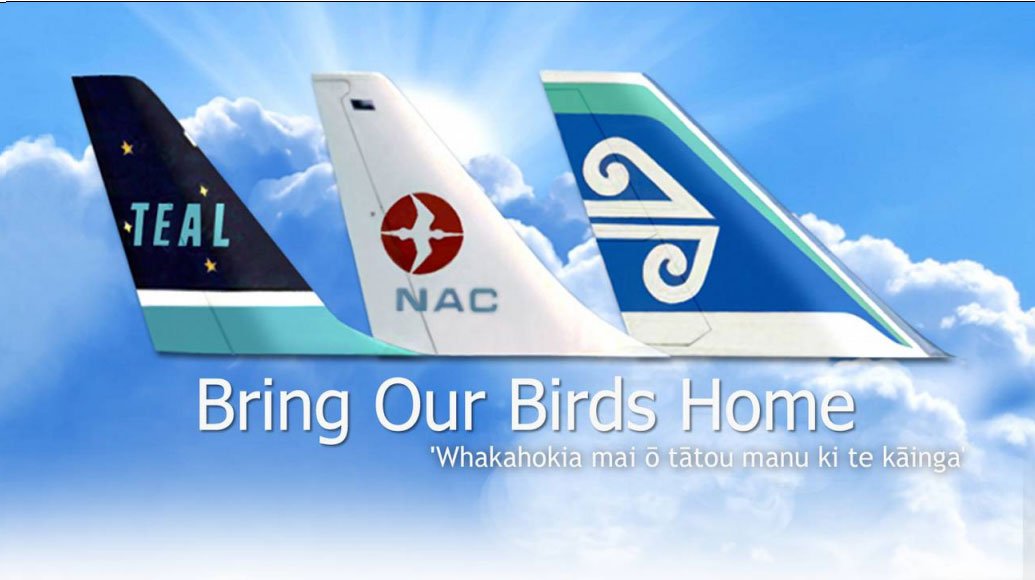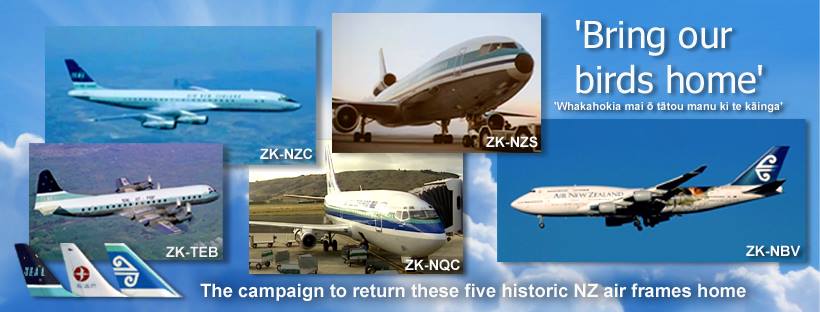A brave and daring bid is underway to save some important pieces of New Zealand’s airline heritage, under the banner Bring Our Birds Home.
Led by Paul Brennan, a classic aircraft fan and broadcaster with specialist experience in filming aviation (who actually filmed some of these aircraft back in the day and was a pioneer of aviation webcasting), the campaign aims to bring five classic airliners home to New Zealand for preservation. Each aircraft has a particular importance in the history of aviation in the country, and are genuine airframes which formerly flew for the country’s airlines.
We caught up with Paul to ask him about the project and how it’s been going so far.
 How did this project come about?
How did this project come about?
“‘Bring Out Birds Home’ started off with a simple idea, to check and see if five aircraft types (missing from our country’s aviation artifact collection) that were originally ordered and delivered to TEAL and Air New Zealand had survived intact… remarkably it turns out that only one original copy of each of the aircraft types remain, half of them abandoned and derelict at locations around the world, ranging in age between 19 and 60 years.”
Which aircraft are involved?
“They are the last remaining examples of fleets ordered by and delivered to TEAL (forerunner of Air New Zealand) and Air New Zealand itself, including a Lockheed Electra, DC-8, DC-10, B737-200, B747-400.”
Specifically, the aircraft are:
- Lockheed Electra ZK-TEB (currently C-FIJX with Buffalo Airways)
- Douglas DC-8 ZK-NZC (N42920. WFU Manaus, Brazil)
- Douglas DC-10 ZK-NZS (F-GTLY. WFU Havana, Cuba)
- Boeing 737-200 ZK-NQC (C-GTVO. Airworthy, stored Montreal, Canada)
- Boeing 747-400 ZK-NBV (currently EC-MDS with Wamos Air)
Today, these aircraft are scattered around the globe, meaning a mammoth task is at hand o secure ownership, recover and relocate the aircraft back to New Zealand – especially considering two of the aircraft are now in a non-airworthy condition a long way from home.
Watch the Bring Our Birds Home video trailer here: http://www.ziln.co.nz/video/11088
As well as their genuine New Zealand heritage, these aircraft have a number of tales to tell. In Paul’s words, they are ‘five air frames of national significance’. They include the airliner type that brought the Beatles to New Zealand, an aircraft that was once fit to carry the Queen, New Zealand’s hardest working airliner which carried over 2 million domestic passengers and more than 100,000 tons of freight over 30 years, the aircraft that took the country into the jumbo era, and the former ‘Lord of the Rings’ 747.

Lockheed Electra. Photo (c) Bob Leask


Boeing 737-219. Photo (c) James Brennan.

DC-10. Photo (c) Mannering & Associates

Boeing 747-400. Photo (c) coralsea.sakura.ne.jp
To date Bring Our Birds Home has secured first right of refusal with current operators to purchase the Electra, 737-200 and 747-400, which are all still in service. However, in the meantime it is setting its sights on acquiring the Douglas DC-8 which is in a sorry state at the side of Manaus airport in Brazil, having last been operated as a freighter by TCB.
“The DC-8 at this stage, which we are closest to making an offer on should our approach to Infraaero (air frame owner) be accepted, is going through the process now,”
Paul adds “The DC-10 case depends on the attitude of the Cuban CAA who we are now in discussion with via the Cuban Ambassador to New Zealand. They control the derelict air frame at Havana Airport.”

TCB DC-8 ex NZC Manaus Brazil 2017

ZK-NZS Havana April 2017
What are the stages in bringing these aircraft back to New Zealand?
“The DC-8 and DC-10 are non flyable so will need to be dismantled and shipped from the location to New Zealand, the other can be flown in ideally when the time comes – some years in the future.”

An artist’s impression of the finished aircraft collection once on display and repainted in their heritage liveries.
At present the campaign does not have a particular location to display the aircraft once they are brought home, but is hoping to make an announcement soon. All focus is currently on securing the first aircraft and securing funding, whilst awaiting the active airframes being retired.
The purchase cost is likely to be a significant challenge to the project, and Paul is actively fundraising through an online campaign which is going a long way towards the most pressing issues of acquiring the Douglas DC-8 and arranging its dismantling and shipping once the purchase is secured.

How the DC-8 could change once brought home.
How you can help
Any fans of classic aircraft will no doubt delight at the prospect of bringing this collection of historic airliners together for public preservation, so I encourage you to get involved and give all you can to see it to fruition. You can donate here: www.givealittle.co.nz/cause/bringourbirdshome
Paul states: “When we get the go ahead to make an offer for the DC-8 the group will alter our status to a Trust to manage the bid, fund raising effort and the asset.”
Please everyone give generously, we only get one shot at this!
You can keep up with the Bring Our Birds Home campaign on their dedicated Facebook page, where Paul shares regular video updates on progress.
[Read our guide to Spotting in New Zealand]






1 comment
Being an aircraft fan and history buff its a great idea to preserve one of each type of commercial aircraft that flew for our national and international airlines.
I wish the project every success and I’ll be donating to the cause through the give a little page